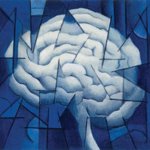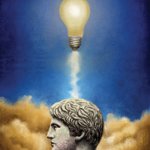
Ivan Sanford, a conceptual illustrator for over twenty years, has a body of work that includes hundreds of commissioned illustrations, and has media expertise ranging from acrylics and oils to digital graphics and animation software.
Ivan attended the School of Visual Arts ("SVA") as an Illustration Major, and while there, had his work selected for the Society of Illustrators and Master Eagle Gallery Students Shows. After graduating in 1986, he started a career in which he created hundreds of illustrations for a various magazines, newspapers, books and websites. In 2006 Ivan had one man show at Columbia University displaying many of the works from his career.
Ivan's illustrations have been used within a broad range of medical, business and other markets, all approached from his uniquely editorial, and sometimes humorous, point of view. His work has covered topics such as risk assessment, management strategies, corporate leadership, consumer home financial planning, healthcare (the business side as well as patient care), DNA research, genetics, cancer treatments, AIDS and psychological disorders.
Other career highlights include illustrating a ten-part national Associated Press series of articles on future life in America, covering such possibilities as national ID numbers, genetically modified pets and 3-D holographic movie theaters. For National Review Ivan illustrated Richard C. Cowan's essay How the Narcs Created Crack - a War against Ourselves. For Viking-Penguin Ivan illustrated a cover for Madison Smartt Bell's New York novel, The Year of Silence.
Over the course of his 20 plus year career, Ivan has expanded his skills to include computer graphics and animation, creating work for television shows such as CBS News’ Coast to Coast, Discovery Channel’s Rosenberg File, Case Closed, and A&E’s Biography, along with commercial and corporate animation work for Chase, Mobil, BMW, SunAmerica, Proventil, Raytel, Boehringer-Ingelheim, and Health Learning Systems.
Furthermore, Ivan has served as Executive Producer on a diverse range of interactive projects including e-commerce website applications, touch-screen kiosks, video-on-demand applications, commercial DVDs, and streaming media video productions for Estee Lauder, Elizabeth Seton Museum, Hargray, Globix, Kenneth Jay Lane, People's Choice Awards, Paulson & Co., and many others.
His clients include New Jersey Monthly, Business International, Risk Management, International Business, Management Review, Financial World, American Demographics, CBA Marketplace, Economist Intelligence Unit, Merck, SmithKline Beecham, Pfizer, Lever Brothers, Roerig,
Fisons Pharmaceuticals, Knoll Pharmaceuticals, Schering Plough, ICI Pharma, Healthcare Forum,
Minnesota Medicine, Medical World News, New Physician, Medical Economics, Rhode Island Monthly
McMahon Group, Slack publications.
CLIENT LIST
- American Demographics
- Business International
- Economist Intelligence Unit
- Financial World
- Fisons Pharmaceuticals
- Healthcare Forum
- International Business
- Knoll Pharmaceuticals
- Lever Brothers
- Management Review
- McMahon Group
- Medical Economics
- Medical World News
- Merck and Co., Inc.
- Minnesota Medicine
- New Jersey Monthly
- New Physician
- Pfizer Lever Brothers
- Rhode Island Monthly
- Risk Management
- Schering Plough
- Slack Publications
- SmithKline Beecham
Q & A
Through what creative process do you get your best ideas?
When creating an illustration, I first read over the content assiduously. Then I may focus on another task and let it bubble in my subconscious for a while. Sometimes good ideas for the image will later “rise” to the surface while walking or talking. I try to have a pen and notebook with me for when this occurs. If I don’t have a pen and paper available, I will repeat the idea several times in my mind so as not to forget, similar to remembering a dream. In other cases I may need to push harder for a good idea. I often see a conceptual idea as similar to the structure of a sentence. In a conceptual image there are symbols (subjects) and actions (predicates). If need be, I will create a “subject-predicate” list to get a good concept, looking for clever ways to put them together.
What is your favorite assignment anecdote?
I recall a few times, when a really good illustration idea popped up just prior to meeting with an art director or editor. In those instances, I took out my pen and paper and sketched it right then and there on the street.

 Paul Anderson
Paul Anderson Katie S. Atkinson
Katie S. Atkinson Rob Colvin
Rob Colvin Dave Cutler
Dave Cutler Robert Dale
Robert Dale Todd Davidson
Todd Davidson Maravillas Delgado
Maravillas Delgado Phillip Dvorak
Phillip Dvorak Yvetta Fedorova
Yvetta Fedorova Warren Gebert
Warren Gebert Andy Giarnella
Andy Giarnella Paul Gilligan
Paul Gilligan Lael Henderson
Lael Henderson Janusz Kapusta
Janusz Kapusta Igor Kopelnitsky
Igor Kopelnitsky Scott Menchin
Scott Menchin Adam Niklewicz
Adam Niklewicz David Ridley
David Ridley Alberto Ruggieri
Alberto Ruggieri Ivan Sanford
Ivan Sanford Pedro Scassa
Pedro Scassa George Schill
George Schill Roy Scott
Roy Scott Miriam Selmi Reed
Miriam Selmi Reed Doriano Solinas
Doriano Solinas Cost.
Cost. Kari Van Tine
Kari Van Tine Paul Vismara
Paul Vismara Gary Waters
Gary Waters Richard Weiss
Richard Weiss Christopher Zacharow
Christopher Zacharow Farida Zaman
Farida Zaman Leon Zernitsky
Leon Zernitsky



